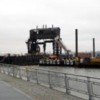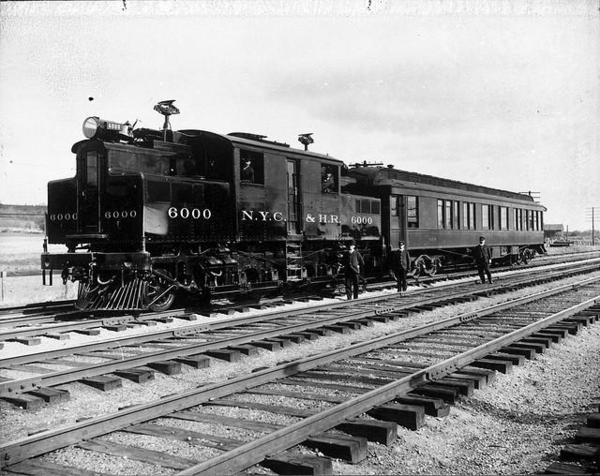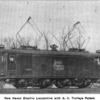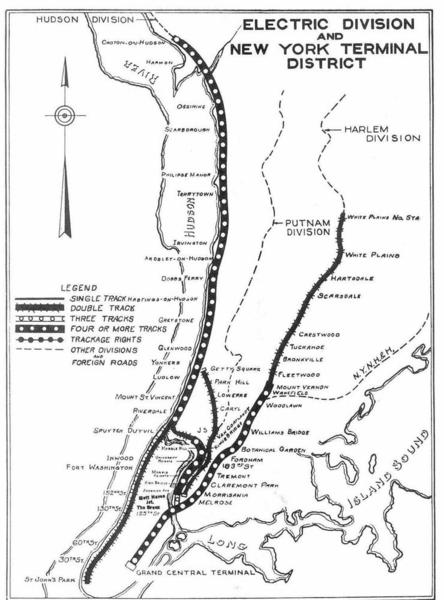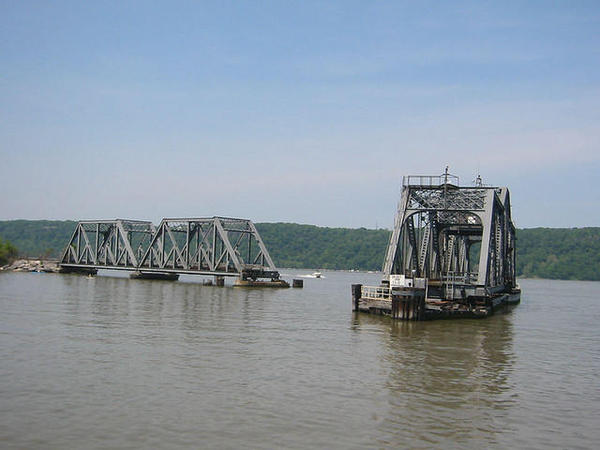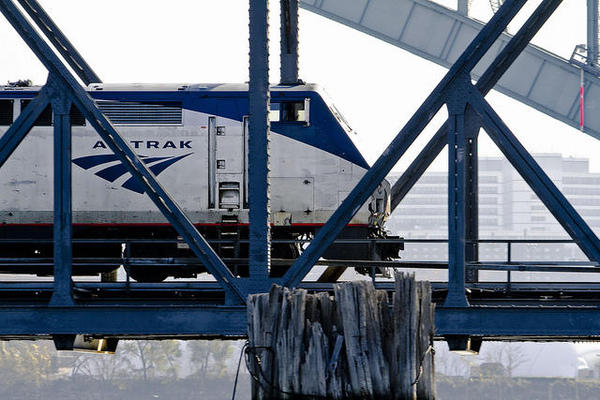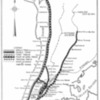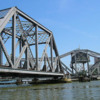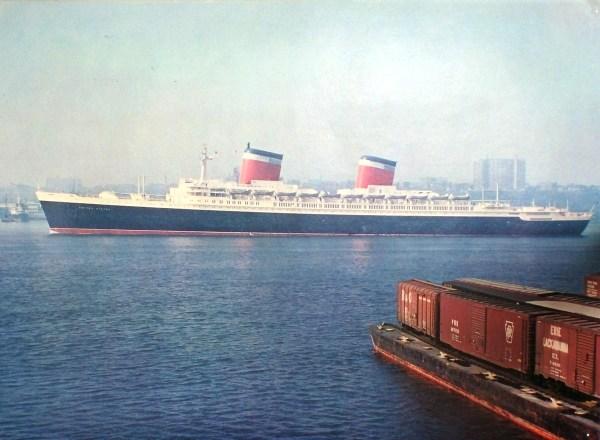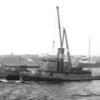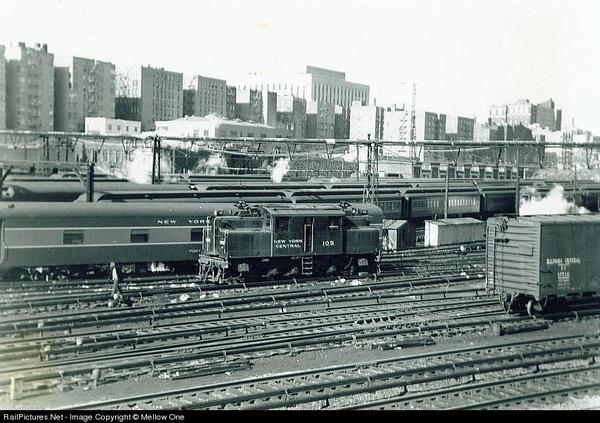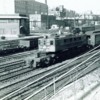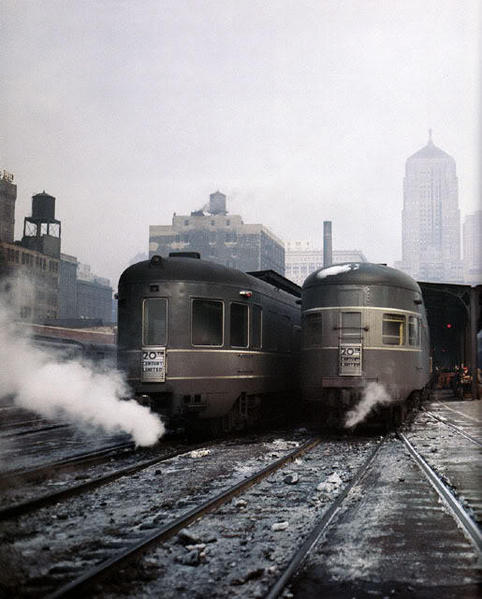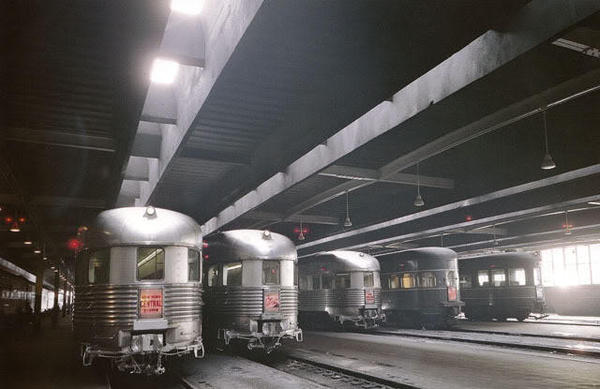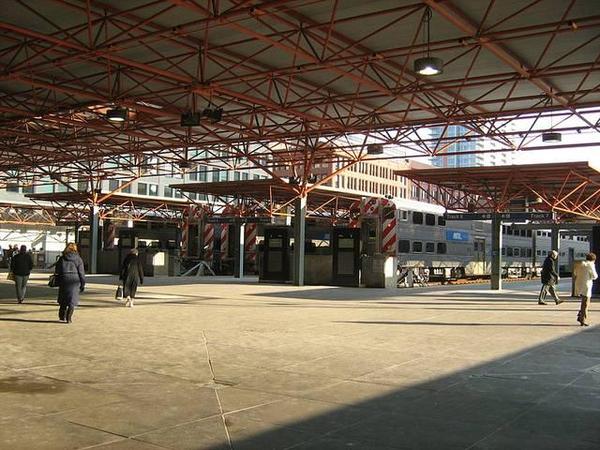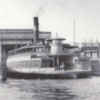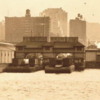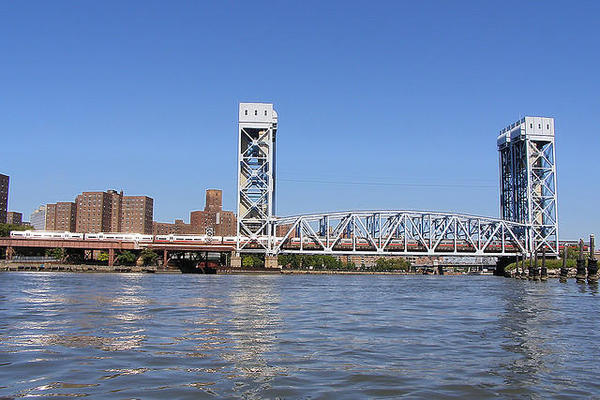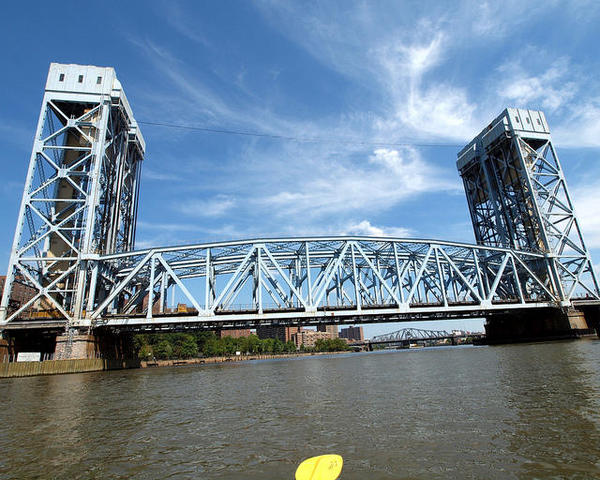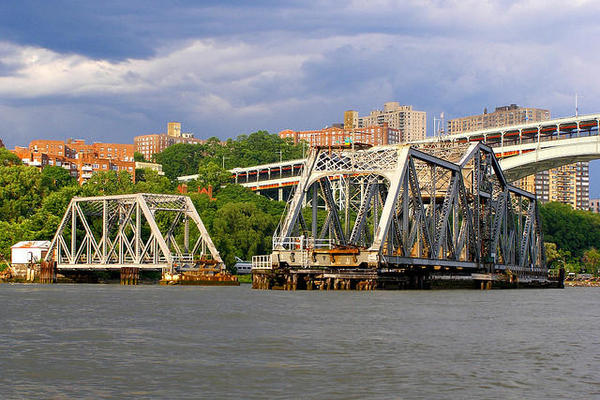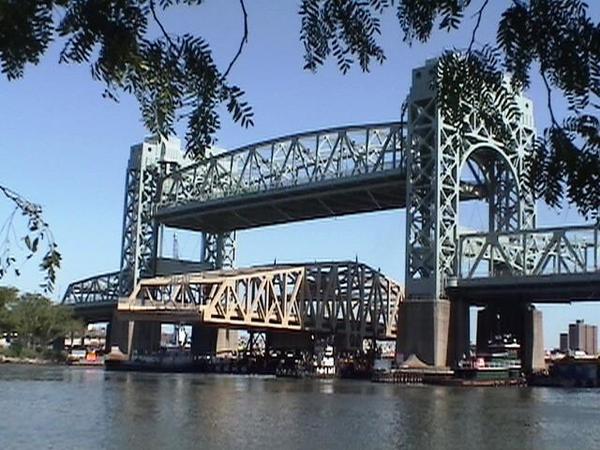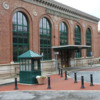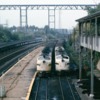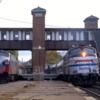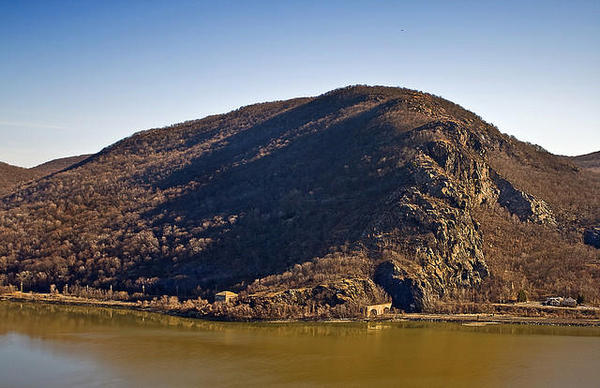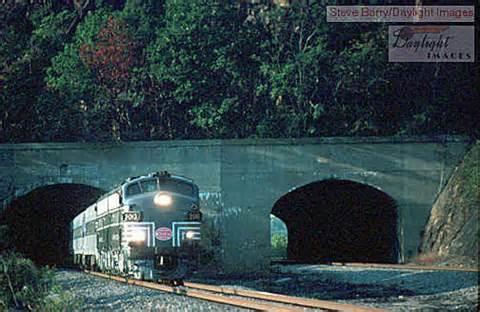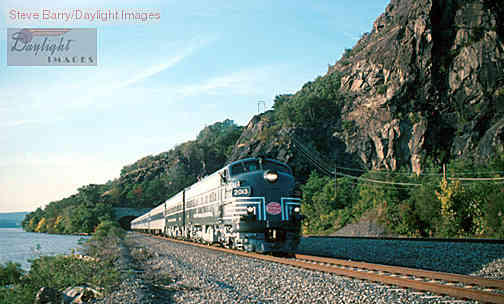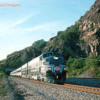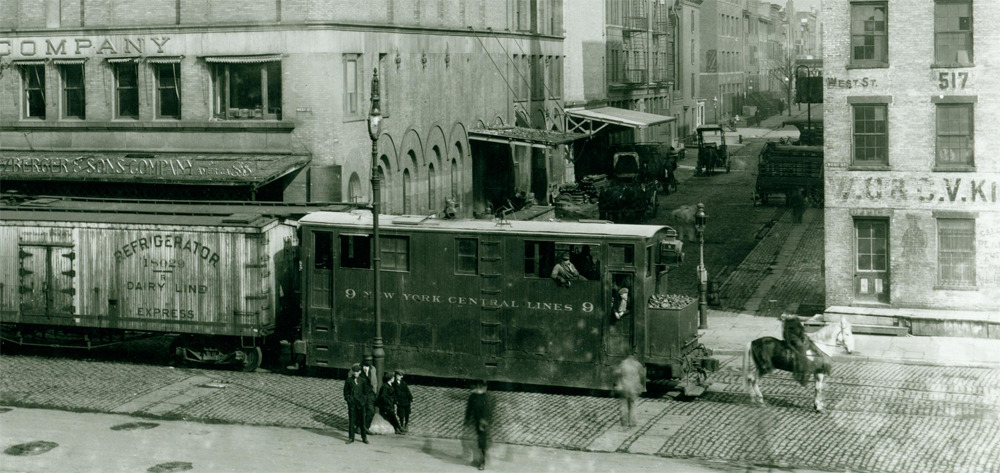
Replies sorted oldest to newest
Before the New York Central High Line on the west side of Manhattan from 34th St. south to Little John St. serving the general post office and the meat markets and other industries. The locomotive is a Shay shrouded as not to scare horses that were used to pull wagons until motor trucks were fully used in the early 1920's. The person on the horseback acted as a flagman when crossing at intersections and were known as west side cowboys. The high line opened in the early 1930.s.
Great historic photograph. Thanks CCrider.
That's Classic! Modern tri-power with a horse escort!
Bob
The photo you posted is interesting as some of the cars in the photo are from 1939-40. Still street running in Manhattan this late. I believe the Horsemen were referred to as the "10th ave cowboys."
Definitely would not have guessed horses on the streets of NY that late, and, to the right in Bob's photo I see the rear of a "Fleetline" GM car, 1942 for sure, and maybe 1947-48.
You can see a 1939 Pontiac (with its trunk striping) just to the right of the loco. Uh..
were those REALLY Shays, even in that earliest photo above? Those later are boxcab
diesels? No visibility safety striping across the fronts of the locos as common to gas
electrics of the period......wonder if they operated at night, with the horseman? And
wonder what the horses thought with that just behind them?....took some training.
That last picture is the St Johnsbury building on West and W. Houston St. Was a large freight transfer warehouse as can be evidenced by the number of tracks and the number of truck loading docks I was in that building many times as Merrill Lynch took it over in the 1970's and had one of their largest data centers in it What was once all trains became all mainframe computers
The pictures of the 10th ave cowboy are north of where the high line terminated hence still street running You can see the high line behind the horse in one of the pictures
GREAT photos! ![]()
Though it was barely used, I once saw a freight car being moved up on the high line back in the mid 70's or so. According to legend, the last delivery happened around 1980, supposedly a load of frozen turkeys. At one point they had proposed putting light rail on the high line, to add to the transportation system on the far west side of Manhattan, but it obviously never happened. Ironically, one of the reasons they proposed the light rail was to help spur development on the west side, replacing mostly moribund warehouses and such with new businesses, and the high line park that now is finished up into the 30's, has done just that, the land along the high line is now some of the most expensive in NYC, all these high end shops, restaurants, apartment buildings and the like (me, I kind of liked the old days, could do without the beautiful people and all the young twits drinking themselves into oblivion, but that's me). In any event, when the weather is nice, if you get to NYC, go for a stroll...they have sort of recreated the train tracks on the high line, so you at least get a glimmer of what it was like. The High line was a classic example of something obsolete by the time it was built, it was finished just as trucks took over a lot of the shipping for the meat packing district and the west chelsea warehouses and such.
Addig to the evolution of the S class locomotive story we have: These engines trace its heritage to what we know in prototype as the New York Central S-1, S-2 class electrics developed for the conversion to Electric Propulsion to Grand Central Terminal. The Original locomotive numbered 6000 was delivered in 1904 for testing. The design was refined including the addition of the pilot trucks and duplicates , the S-2 class were ordered in 1906. Actual Electric Service began in 1907 and at that time the locomotives were numbered in the 3400 series. In 1908, a final order was delivered with what was the S-3 class. These were numbered in 3200 series and the earlier locomotives were all renumbered into the 3200 series as well. The Prototype no. 6000 became No. 3200 . This was the number that IVES assigned to their O Gauge version of the engine.
These locomotives were used on the New York Central Electrified lines right into the Penn Central Era. The Original class engine No 6000 which became No 3200 in 1908 , was again renumbered in 1936 to No. 100. Many will recall Lionel's recent scale model of No. 100. Suffice it to say that back in 1910, these machines were capturing the imagination of toy train hobbyists and or boys and therefore the Ives No 3200 in 1910. Lionel also offerred models of these engines in that time both Standard and O gauge.
Great photo of the 3401 . The changes you can pick up are interesting including the pantograph design, the headlights and the change in the letterring. Notice this one says New York Central Lines but still has the NYC&HR under the number.
these motors returned when the central made the decision to modify them for service into Grand Central in 1955. When they were completed , the factory painted these in the two tone gray lightning stripes which i believe was a first for an electric locomotive on the New York Central. T motors were also done in the mid 50's. Some of these in this scheme lasted into the Penn Central Era. Thanks for posting the photo Bob.
I find it hard to believe that so much of the NYC rails were elevated. When I went there, I saw elevated roads and also wondered if they're on any of the old railroad stuff? I guess when space is tight, it justifies the extra work and expense.
You guys are probably used to seeing it. If you're from different places, maybe you'd wonder why too?? Looking just at the pics, it seems like all the RRs had a tough go of it there, with the space and the water. So much in such a small area going on. People probably wondered why I was staring at the elevated pieces so much.
I'm still amazed. It really is the "big" apple. They weren't messing around, were they?
I guess each area of the country has demands. Mountains, rivers, etc., all get conquered by the RRs.
Too bad they let go of the Buffalo Term here. It's built on such a huge scale. Would have been great to refurb it like the Grand C was. Just rambling again.
Keep in mind the high line was kind of a unique thing, even in NYC. The reason it was built was because of the danger of rail traffic at street level along 10th avenue)...from what I know of the rail yards and the tracks in/out of NYC, most of them were ground level, the west side tracks that Amtrak uses these days, for example, are in deep cut or ground level most of the way, with some sections raised off the ground, specifically around 125th street. One of the big yards are located where there is the Trump Development up in the 70's, that is built over the old NYC rail yards. The old Penn Yard still exists, it is used by LIRR and NJtransit and amtrak these days, and soon will be covered over for a future development (still used, though).
The west side of Manhattan also had all these railroad ferry slips, where I assume they 'floated' freight cars into Manhattan, by the time I remember them, in the 1970's, they were long abandoned, many of them later had fires and such, most of them now, fortunately, have been torn down, they were eyesores. I don't know if the Pennsylvania every used its tunnels under the Hudson for freight (I assume so, but I don't know), so the other railroads I would assume had to use car ferries, or they would bring them in from the north.
The big rail yards in the city were in places like the South Bronx and out in Queens, where the space was available, the ones in Manhattan from the pictures I have seen were relatively small (thought tucked into Manhattan, pretty impressive).
The New York Central also ran down the Hudson on the other side of the river. It terminated in Weehawken NJ Weehawken was miles and miles of Railroad yards. The New York Central had a large ferry terminal there
Attachments
Thanks for the photos of Weehawken. Although much of the modern day passenger trqins operating out of Weehawken were commuter runs, The New York Central did operate to Albany from here and New York Ontario and Western had trackage rights over the New York Central to Weehawken for its trains. The NYO&W operated many trains to the Catskills from Weehawken in the summer. The New York central ferries reached Weehawken from two Manhattan locations: W 42nd street which was a quick crossing but had the added attraction of offerring a great view of the transatlantic liners when they docked in New York and a longer trip from Cortland street , about 25 minutes in Downtown manhattan. IT was one of the nicest rides on the Hudson River Ferries and you could get a great view of the port facilities in New Jersey and on the other side, the New York Piers as you worked your way up the Hudson River.
Nice photo of the NYC Niagara. It looks like she is heading downtown to the Cortlandt st slip. There is also a boat at the 42nd street slip probably getting ready to depart for weehawken. Also across the river is an American Export Liner moored at the pier . The Hudson River Day Line boat is tied up as well.
Judging by the light and the makeup of the NYC train in the photo, I would guess that we see the Twentieth Century Limited making its final leg into Grand Central from Chicago.
Interesting about the steam heat trailers. No one yet has made one of these in O gauge . These type of cars were used by other railroads as well. I read recently that the Union Pacific had these typse of cars and needed them because of train length, ie the train was of a length that the steam boilers in the diesels gouldnt generate sufficient steam for such a lenghthy train.
This is a fantastic thread guys!! Thanks so much for posting these photos. I am a New York City fan and of course New York Central fan as well....love the history lesson here!
Alan
On the West side freight line, the Central had a large yard and marine facilities at 60th street. Today its a park and there is an Alco Switcher on display and a float bridge being restored. Take a gander at some photos of the yard in 1960 and now.
Attachments
As a kid growing up I lived close to the New York Central Harlem Division 3rd rail Electric Line. I would sit on our porch or along the tracks and watch trains, MU cars, T1 Electrics, and later on P motors go by. At about rush hour long express commuter trains with many cars would rush by. It was a way to pass the afternoon by counting the cars.
Once in a while when returning home from school a work train handled by a steamer would be working the line. Boy was that exciting to see. In the winter I did notice some express trains with a steam heater car behind a freight locomotive (Motor) with a trail of steam exhaust coming out of a stack. Did not know what that was for till many years later.
I also would see double headed S motors pulling express trains. Later on I would see them at Grand Central Terminal working as switchers shunting cars around. So when Lionel came out with their model of the S1, I put my money down and quickly bought one..
I used to work with a gentleman who had been an engineer for the New York Central and used to run S1 motors. He had a story about the motor getting hung up (stuck in neutral). The fix was to go to the front or back where the electrical stuff was and whack a relay or something like that with a 2x4 and it would start up. I guess it was a temporary fix for a 60+ year old electric.
Here is an article on 10th Avenue trains and the "The Original Urban Cowboy" - with video.
Great info and pics but video does not play?
This is right under the West Side Highway . There were some interesting trains that came down this line. Milk cars were brought from the Rutland interchange at Chatham NY . This was milk from the Vermont Milkshed. There were processing plants uptown around 110th street and one further downtown. Also general freight some of which was floated to various locations around the NYC waterfront. There were the meat reefers as well for all the packing houses on the West Side. New York Central ran M&E trains down these lines as well. In an earlier post , someone had noted no passenger trains on the high line but M&E and Milk Trains were operated on passenger schedules.
In the photo, the billboard with the airliner is very interesting. Also that passenger car next to the locomotives looks like its used for an office. I wonder what the sign placard on the end of the car was used for.
 Here is an interesting one Park Ave with he tracks still visible
Here is an interesting one Park Ave with he tracks still visible
Great picture! Question, was the train there all along and what became park avenue built on top of it? I would assume so, given that when the rails were put in, Manhattan above 42nd street was sparsely populated.
When the Grand Central Terminal projetc was undertaken around the turn of the century, the tracks leading to the existing station were lowered in the vicinity of the staion, probably from about 96th street south. North of there they were elevated.
When the terminal was built, tracks were lowered in the area one by one, moving from East to the west. The two photos show the tracks as they existed after lowering but before the railroad was completely decked over. In the last photo, you can see the steel framework starting on the right side of the street. The earlier photo is probably about 10 years later but before the median was completely covered over.
Those are awesome pics Ben & Bob. While not appropriate for my era (late 60s thru early 80s) I think I will incoprporate that open median look into my future layout. Very cool. ![]()
This photo is quite interesting in that it shows the actual construction plan that was followed to build the new terminal while the railroads maintained service as well. You can see tthat they were excavating and lowering a track at a time starting on the east side of the station and moving west as they progressed.
The electrification was in service by September 1906 for the New York Central and the following april and May for the New Haven Railroad.
The entire terminal project was completed in 1913 following about a 10 year program of planning design and construction without interrupting service in and out of the terminal. GCT is celebrating its 100th Birthday this year. There will be a Parade of Trains celebration this coming weekend May 11-12th. About 40 pieces of equipment including Metro North Equipment and private railcars will be open to the public.Also a train show and display in Vanderbilt hall. I am planning to go on Sunday
Here is a photo of the first passenger New haven Electrics EP-1. This class was known on the railroad as the Pioneers.
Here is a photo of the Prototype S-1 electric of the New York Central before they went into service.
Another photo of the GCT construction. You can make out the old terminal and the trainshed on the right in the photo
Attachments
Bob
It was probably the New York Central's first revenue electric train leaving the newly electrified Grand Central Terminal. This train is in the Western portion of the station and is on grade. On the East Side of the terminal, work was already underway to depress the tracks below grade. Service to Grand Central Terminal was electrified about 6 1/2 years before the present day Terminal was opened for traffic.
Bob
Staufers Later Power mentions the first electric revenue run as February 13,1907. So the Photo in the Scientific American predates this so it was a trial run as they say. The cars in the photo are locomotive hauled cars. Per Staufer ,The train on that day was a run up to Wakefield on the Harlem line where there was an engine change/terminal facility. Similar service to Highbridge came later with complete electric service between HighBridge and Grand Central and Wakefield and Grand Central by July 1 1907. MU trains were steam powered north of these points as the cars had provisions for Steam heating as well as electric. The S motors handled the standard rail car trains South of Highbridge and Wakefield.
Those look like pretty big steamers in the Highbridge photo, probably early pacifics.
Here's an aerial view of the Hudson Division in the Bronx showing 2 famous New York City landmarks:
Peter
Attachments
I have been looking at this picture wondering why both pantographs are up. Was this before they figured out to just leave the back one up? Or was this just a phot op

I'd love to find an online reference showing the paint and lettering scheme of the cars in the trains the first S-1s pulled. Am working on a tinplate version of that train and need pics for lettering reference.
Thanks,
Bert
I'd love to find an online reference showing the paint and lettering scheme of the cars in the trains the first S-1s pulled. Am working on a tinplate version of that train and need pics for lettering reference.
Thanks,
Bert
Hi, Bert.
I you have access to a copy of the Staufer book titled "New York Central's Early Power: 1831-1916", there are plenty of photographs which show the types of passenger equipment in service during the early stages of S-motor operation (lots of arched windows). I'll look through some of my other material to see what I can find but that book would be a good starting point.
Bob
I have been looking at this picture wondering why both pantographs are up. Was this before they figured out to just leave the back one up? Or was this just a phot op

Ben
I believe this was a builders photo taken at Westinghouse Pittsburgh after completion of electicals. All the EP-1 photos i have seen before delivery seem to have both Pantographs raised. The New Haven ran with Rear up only.
Bert
Question.......
When a passenger train came into Grand Central in the diesel era, did they change to electric engines in Harmon......Or, did the E & F units take them all the way in?
Peter
Peter
In the days of the New York Central and New Haven through 1968, diesel trains on the new york Central would have an engine change to a P class or T class motor at Harmon on the Hudson Line and North White Plains on the Harlem Line. On the new Haven, Fl-9s would be used on run through trains since they were dual mode. When Penn Central came about, and the New Haven subsequently being merged into PC, the electric motors were retired rather quickly and all Trains originating in non-electrified territory began to use the FL-9s. Eventually Amtrak acquired some of these units from the New Haven Pool and operated long distance trains into GCT The FL-9s were used into the early 90s when Metro North and Amtrak were equipped with the dual mode Genesis engines. About that time, Amtrak trains were rerouted into Penn Station . The Genesis engines still call in GCT for Metro North.
Today we visit Spuyten Duyvil. In the New York Central's electrified areas, the West side line diverged from the Hudson River line at this location. The line going down the West side was reached via a swing bridge which still is used today by Amtrak Empire Service, The lake Shore Limited and the Maple Leaf . The connection to the Hudson Line had a Wye so that it was accessible from both directions on the Hudson Line. Using the Wye at Mott Haven, trains coming down the Harlem Line could also reach the West Side line .
New York Central operated a number of Mechandise and Express trains, Meat reefer trains and Milk Trains down the West Side Line. The R motors handled these trains and they all went through Spuyten Duyvil. Here is a line map showing the lines in the New York Central electrified division:
The swing bridge was fairly low to the water as it crossed the Harlem river. Usually it was closed when a train needed to cross. Here are some bviews of the Bridge.
From the air, we see the Swing Bridge in the Foreground with the highway Henry Hudson Bridge above and behind the Spuyten Duyvil. In the 1950's the toll on the highway bridge was 10 cents.
Looking at grade level from the Upper Manhattan side of the Spuyten Duyvil crossing
.
Amtrak heading into Penn Station with a New York Area train. This route has been in effect since the early 1990s
A Former New York Central post war electric in Penn Central colors is leaving the area through the rock cuts.
A Northbound Metro North Train Poses at the Spuyten Duyvil station with the swing bridge in the background.
Attachments
Hudson, Harlem Division & Putnam Division.....there is lots of good reading about......I wish someone would do a comprehensive book on the West Side Division's history and development.
Here are some books I own and can recommend:
How about someone writing a book on the west side branch? I'll buy the 1st copy.![]()
Peter
Attachments
Ok lets focus a bit on the Marine aspect of the New York Central. The railroad had extensive operations in New York Harbor. There were carfloats at 60th street on the West Side and across the Hudson at Weehawken. Besides transferring cars accross the Hudson, There was interchange by floats with other rail lines in New York harbotr as well as terminal lines such as the Brooklyn Eastern district and Wallabout Bay. The New York central also operated a number of pier stations throughout New York City on both the Hudson and the East Rivers. Floast, barges and lighters also loaded/unloaded ships in the harbor. The Ferry to Weehawken ran from two terminals, one at West 42nd street and a second downtown from Cortlandt street. Here a a few shots of New York Central tugs in the harbor.
No 27 with a stick lighter
Maybe a NYC float but certainly a grand photo of the liner United States leaving on a transatlantic crossing.
Rival PRR had extensive marine operations also. Heres a PRR boat on the DeBrosses street ferry to exchange Place. This was one of the first ferry routes to shut down that I remember in the late 1940s.
And we need to show the LIRR presence in the harbor even though this is a New York Central Themed thread. Here is the LIRR Meitowax on the East River,
Attachments
LIRR....thanks so much for the NYC tugboat pictures!! I just finished a project where I built a small barge and darned if it doesn't look similar to the second picture in your post above. Love the photos!!
Thanks,
Alan
You are welcome Alan. We have a lot of prototype photos on this thread but it would be good to see some modeling of tugs, barges etc. So I hope that we can see a few photos of your model here on this thread. And if anyone else has some models that fit in, lets see some photos of these on this thread as well
Lighterer Lehigh Valley I believe

Lionel Tug Santa Fe UGhhhh!!

Some custom tugs




Attachments
Attachments
The Polo Grounds are just across the river where the New York Giants (baseball) played before moving.
I went to a Mets game at the Polo Grounds in 1963. Jim Hickman hit a grand slam and prevented Roger Craig from losing his 19th in a row!
We took the #4 and walked across the bridge.
Peter
Hi, Steamer:
I checked the Scientific American article and the caption identified the train as a "trial" run. I believe, although corrections are welcome and invited as always, the first electric train to carry fare paying passengers was an MU for Yonkers. The train ran on electricity as far as Highbridge at which point a steam locomotive was added to power it the rest of the way. Speaking of Highbridge, I found this great picture of the engine terminal during the very early years of electric operation before the third rail was extended to Harmon. Plenty of steam here...
Bob
Here are a few photos of the New York Central at High Bridge (past and present).
2013 - Looking north (Harlem River on left side of photo)
2013 - Looking south at High Bridge (from on top of the High Bridge)
1906
Attachments
The Central serviced passenger coaches in the Bronx at its Mott Haven Yard . This is where the Hudson Division amd the Harlem Division came together. The Yard had a Wye in it connecting the harlem division to the Hudson Division. A train running South on the Harlem division could access the Hudson Division directly. Milk trains coming down the Harlem division could reach the dairy plants on the West side line using this wye. It is still in place today.
Just South of the yard. New york central train with a P class motor
A New haven Train just about same spot. The Hudson Division breaks to the left while the Harlem line is in the foreground
Attachments
Great shots of Mott Haven!
Is the building in photo 3 with the arched windows Cardinal Hayes HS?
Peter
Ben....what kind of barge is that in your first picture above? Is it a custom model and if so any info on it would be appreciated.
Thanks,
Alan
At the Western End, The Central arrived in Chicago for most trains at the LaSalle Street Station in Downtown Chicago. New York Central used the station until 1968.Eva Marie Saint and Cary Grant arrived at LaSalle street after sharing a room on the Twentieth Century Limited in North By Northwest.The Station was used beyond that by the Rock Island and I believe a commuter station METRA still is on the site today. It serves what METRA calls the Rock Island district. You can still go to Joliet from LaSalle Street.
Here is the entrance to the old LaSalle Street Station in New York Central's Heyday.
Busy Morning for the NYC as the Century ran two sections into LaSalle Street station on this day
And Here is the Afternoon Lineup. The Century and the Commodore are on the far right while other NYC varnish including New england States and the Wolverine are in the foreground. hese were the G;ry days of the Great Steel Fleet.
The Rock Island Commuter trains used this station when it was demolished in 1981. This Photo is interesting because it more or less replicates train time for the Great Steel Fleet at LaSalle Street station but Rock Island Style. a bit different from the NYC days would you say.
METRA operates the Rock Island district from the current station on this site. Looks like the same equipment from the 1981 Photo.
Nest Stop Englewood maybe!!
Attachments
On the Harlem Line , we have a Steam Powered local doing the mail run. RPO about to pick up a couple of sacks of Mail . Station is Chappaugua and could be a NYC Pacific at the point. Photo looks to be mid 30's or so
Attachments
Re: "Great shots of Mott Haven." The building with the arched windows is the Bronx GPO at 149th St. & Grand Concourse.
The NYCRR & PRR tugs were unique in NY harbor. They had tall stacks & wheel houses. The other railroads involved in lighterage and car floats in NY had much shorter stacks and wheelhouses because they had terminals along the Harlem River in the Bronx and there was low clearance under the bridges from Manhattan to the Bronx
Peter,
Cardinal Hayes is the building just to the right of the arched window post office building in that photo.
The Hudson division tracks pass alongside the south side of the building (between the PO and the school). Only in 12th grade English class did I ever score a seat right by the window with a great view of the multiple crossings that trains clattered through all day long. A good thing that was the only one, or my education probably wouldn't have been the same!!! ![]()
Jim
The New York Central and Pennsylvania RR had large fleets of Steam Tugs . These boats had tall stacks to facilitate draft for the combustion process. The PRR did have some diesel powered tugs. These boats as well ast the diesel tugs of the New Haven, Lehigh Valley , Erie, Jersey Central and Lackawanna did not need tall stacks and had low stacks. Some boats had low Pilot houses which allowed them to operate on the Harlem river without the need to open bridges along the river. Some of the PRR diesel tugs are still working on the Mississippi. Mcallister acquired many of the NY harbor RR owned diesel tugs.
Thanks, guys........this has been a spectacular thread!
Peter
What a great thread !! Thank you
Clem
Going back to trains behind the first NYC S-1...
I did pick up a copy of the Staufer book "New York Central's Early Power: 1831-1916" at Bob's suggestion. Great book. But no good side shots of the cars pulled by the first S-1.
Anybody have more suggestions about where to find photos showing the text on the side of the cars in this pic?
Thanks,
Bert
Attachments
Bert you might find what you are looking for in these links
http://passcarphotos.info/Indices/NYC1.htm
http://passcarphotos.info/Indices/NYC2.htm
From the CSRR site: Prior to 1934 - Cars painted Pullman green - roof, underbody and trucks painted black. 5" Roman style gold leaf lettering ( headend cars used yellow lettering). Dining cars, coaches and headend cars lettered NEW YORK CENTRAL.
I may try to find appropriate decals in HO, scan and rework to make artwork for rubber stamps...
Hi Bert
your pre 1934 writeup is i believe what you are looking for.A car which had sleeping accommodations such as sections, cars with bedrooms and observation cars would have been owned and operated by the Pullman Company and lettered for Pullman . This might also have been the case for Parlor cars in this period.The colors would have matched the NYC cars.
Grays on the New York Central probably first appeared with the 1935-36 Mercury. New lightweight cars arrived in 1938 for the 20th Century Limited and some other top trains such as the Commodore Vanderbilt and the Ohio State Limited . These were in the grays Smoothside , those without fluting, cars purchased in the postwar period were also gray except for commuter coaches. In 1956, New York Central took over its sleeping car operations from Pullman so the Pullman name was dropped from cars which carried the Pullman designation.
The Blade Lettering style first started to be used about 1936, appearing on the T series electrics.Electric motors were always black until the Pclass motors were rebuilt in 1955 for GCT service from CUT service. They were painted in the Grey Lightning stripes at GE's factory. T motors also started to be repainted in the Grey Lightning stripes around this time.
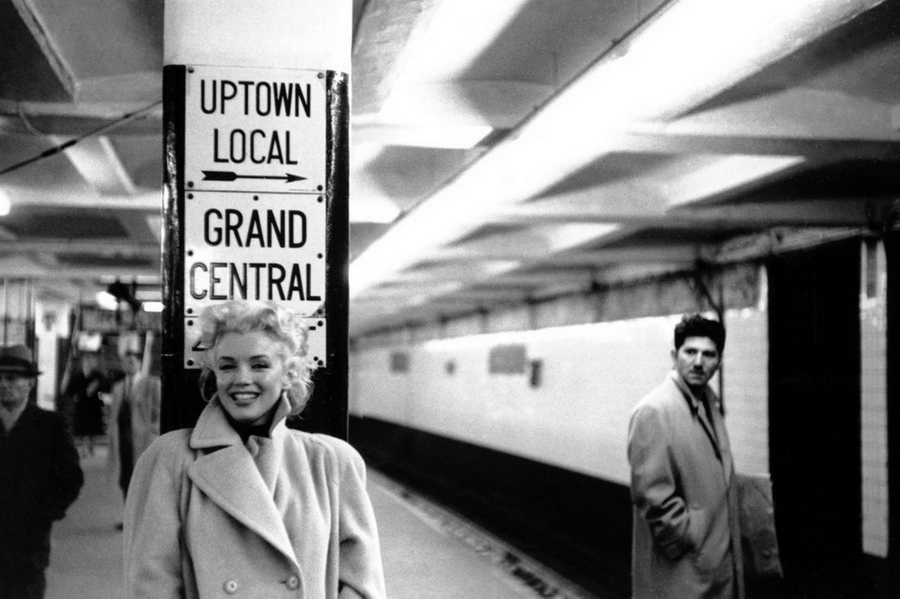
Hey Sno Is that you checking out Marilyn's back
HA HA U CAUGHT ME.![]()

This is a fantastic thread....thanks very much to all of you that keep it going....so much interesting information here!
Alan
The New York Central Main Line ran in the street in Syracuse . Here is a shot of some NYC varnish on the streets of Syracuse in the early years of the twentieth Century.
Attachments

Jake Gyllenhaal looking a little scruffy there. I wonder if that's a movie script he's reading.
A few more from Weehawken




Always loved this Flash Gordon looking motor

Ok Ben has taken us across the Hudson for some West Shore action. We were able to access the West Shore from New York City by taking the New York Central Ferry from West 42nd st to Weehawken. The New York City terminal was a busy place even before the West Side Highway was built in Manhattan.
Heres a New York Central Boat waiting to make a crossing
Over on the Weehawken side, the terminal was sandwiched in between the River and the Pallisades. You could get to the terminal in New Jersey by means of the Public service Trolleys. Here is a car coming up the road from the terminal. It has a poster for Pallisades park. who remembers that place from your youth. This photo is very late 1940's . If you look closely down at the yard below, you can see a lackawanna Baggage car . Its painted in the Maroon and greys.
The Railroad right of way leaving the station went through a tunnel through the Pallisades . Here is a shot of one of the bores. It kmakes for a unique style of RR Tunnel Portal to model on your layout.
In the immediate post war years into the early 1950s, there was lots of New York Central Steam at Weehawken. The Boston and albany J 2 Hudsons and the tank engines ( K Line model) were sent here to handle commuter runs. In the photo, there is also a unique transfer diesel shifting some passenger cars. The trolley is in this photo as well.
The central had a line which went south of here to interchange freight , I believe it connected with one of Ben's favorites , the Hoboken Shore RR. So for you ben, a little Hoboken Shore action with a pair of 44 tonners. Note there is a swifts woodside reefer in the train consist as well. No Ballantine car I afraid!
Attachments
Great pics Larry The Hoboken Shore RR had a float Woner if that Swift reefer is headed for their High Line location.
Hi Ben
I am thinking that there might be a meat packer down on the Hoboken shores system. This Train is heading North and its possible that it is an empty heading back to Swifts.
There were meat packers on North 6th street in Brooklyn served by the BEDT. These cars were floated over and they were normally in an order to match the packers facilities on the siding. There were three tracks in a row and cars on the third track were lined up with cars on tracks 1 and 2. The overhead trolleys were setup so that the full carcass could be wheeled through cars on tracks 1 and 2 from track 3 into the packing facility of the car owner. Swifts, Armour, Wilson were all on North 6th street.
If you check that Hoboken shore photo on the siding in the right side is an Atlantic Coast single sheet box car. It has a 1940 paint job on the car.
Nope that train is not heading North. Its pointed east and heading to the floats by Maxwell House. The building in the background on the right was just demolished, You can see the Jersey City heights in the background
perhaps that Swift car was going or coming from one of the shipping warehouses or ship lines that the rr served. It would be a rather indirect route for a loaded car going to a Manhattan meat packer in my opinion
Just looked it up Here is the route it took Loaded in Kansas City Santa Fe to Chicago. Erie from Chicago to Weehawken Transfer to NYC was hampered because of broken float bridges Transferred to Hoboken shore at Weehawken Floated from Hoboken to NYC float on upper West side Down the high line to Swift. LOL Just kidding Larry
Ben
Sounds plausible, but I would expect to see multiple cars if this was actual. I think its interesting that this reefer was on the Hoboken Shore to begin with and heading for the float bridge. I wonder what customer might have taken a carload like this. Maybe the Holland American line?
Many railroads had pier stations in New York City. Tugs would bring the cars on floats to the piers and they were loaded and unloaded at the piers. Here is a New York Central Pier station at piers 72 and 73 at West 32nd and 33rd st. The Central had a car float operation with a freight station on land at this point. Carload and LCL shipments were handled here. Some Pier stations also handled produce as well.
Attachments
In New York City, The New York Central crossed the Harlem River in two locations, Spuyten Duyvil on the West side Line where the Harlem River meets the Hudson River and at Park avenue. The park avenue crossing is interesting in that the present bridge is probably the 4th bridge built by the railroad in that location. It is a 4 track lift bridge constructed in 1954 replacing a4 track swing bridge which was built in the 1890s. The swing bridge replaced a draw bridge built earlier which replaced a trestle which was the original span across the river for the railroad.
Here is a newsclipping showing the construction of the present lift bridge located just west of the original swing bridge. Imagine that in 1954, the railroad made the switch to the new bridge with very little disruption in service.
Here is the Lift Bridge as it exists today, about 60 years and four railroads (NYC, PC, Amtrak and Metro North) later.
Over on the West side line is the Spuyten Duyvil Bridge. It is a swing Bridge design and its low to the water. Originally used for the West side freight line which we know as the High Line, the tracks and bridge are used today by Amtrak to route Empire service and Long distance services into New York's Penn station. Amtrak trains discontinued use of Grand central in the 1990's.
From Metro Norths spuyten Deyvil station.
Looking from the Harlem River side
And from the Hudson River side
The New york central was not the only railroad to cross the harlem River over a bridge. The Long Gone third ave and Ninth ave Els had spans and today. The Broadway No 1 train still crosses on a lift bridge. This bridge was replaced in the 1960's and was slipped in place of the old bridge with the removal and replacement being completed over a weekend.
The Harlem River Bridges can open for almost any kind of a boat shipment. Here we have the Replacement Willis ave vehicle bridge making its way to its new home. I think this is probably a most unusual river movement. We have a Bridge crossing under a Bridge.
Attachments
I WANNA B SEDATED,LOL

At Rockaway Beach with Sheena
GABBA GABBA HEY !
I would guess that the pic is at the Bdwy Lafayette station. Conductor must have been going crazy with DeeDee and Johnny holding the doors open
The Northernmost point on the Hudson line for Commuter service today is Poughkeepsie NY. That wasn't always the case and there were several long distance trains that stopped there in the earlier days. There was a connection South of here to the New Haven's Maybrook line which crossed the Hudson on a high bridge, just North of Poughkeepsie. Today there is Metro North and Amtrak service to this station.
Here is what the station building looks like today. Its been worked on as you can see
There are High level platforms here but that is an addition. Here are a couple of trains with FL-9s laying over , probably from the Penn Central or Conrail ERA. Platforms are at Grade. Commuter service at Right in the Photo and the Long Distance trains on the River side. Nice View of the Poughkeepsie Bridge . Its a bicycle path now I think
Couple of trains in the station. A little later in time . Still FL-9s handling the work. They were working for both Metro North and Amtrak Nice to still have this New York Central gem with us.
Attachments
GO YANKEES!![]()

Actually, it is part of a New York State Historic Park known as Walkway Over the Hudson.
Hi
Love all the info on this post, together with the photos.
CNJ3676 you have an incredible knowledge of photos etc.
Great Pictures. Thanks for sharing.![]()
Great pics Steamer, this is my favorite RR as my father, grandfather and uncles all worked for the NYCRR and it just has a place on my layout.Ill never forget the stories my dad used to tell me when we were in the basement playing with the Lionels about the Harmon yards and how he got his finger caught in a frozen coupler it was great seeing these pics Thanks
Up along the Hudson on the Water Level route was a spectacular place called Breakneck Ridge. The rock outcropping came out to the Rivers edge and the central had to tunnel through it . So here are some photos of the location with and without trains.
The Ridge from the West Shore
Metro North Train peeaking out of the tunnel South Bound
This time a real New York Central Hotshot with a pair of E-7s Lightning stripers at the point
How about a little steam ? An L4 class Mohawk on a Northbound train
Heres that Metro Morth a little further south this time
Attachments
Definitely would not have guessed horses on the streets of NY that late, and, to the right in Bob's photo I see the rear of a "Fleetline" GM car, 1942 for sure, and maybe 1947-48.
You can see a 1939 Pontiac (with its trunk striping) just to the right of the loco. Uh..
were those REALLY Shays, even in that earliest photo above? Those later are boxcab
diesels? No visibility safety striping across the fronts of the locos as common to gas
electrics of the period......wonder if they operated at night, with the horseman? And
wonder what the horses thought with that just behind them?....took some training.
That is indeed a Shay in the first picture. Note the coal bin on the front of it. I've seen other pictures of the shrouded Shays on the West Side of Manhattan.



























